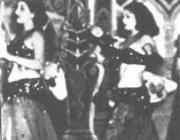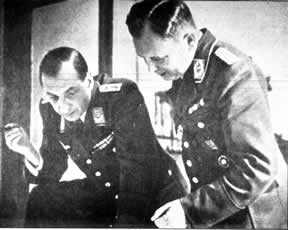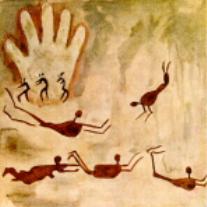Almasy è nato nel 1895 a Borostyanko
o Castello di Bernstein (l'Ungheria dell'Impero Asburgico d'allora, ora Burgenland Austriaco).
Secondo figlio di un borghese ungherese e di madre stiriana, divenne pilota collaudatore della Steyr
(Stiria) fabbrica di Graz. Con questa marca
compì vari collaudi di mezzi nel deserto Egiziano. Per inciso la Puch-Steyr produce
ancora oggi autotrazione
integrale (la panda 4x4 a trazione integrale è Steyr). A 17 anni sapeva gia guidare gli aerei e come pilota partecipa alla
Grande Guerra (1914-18) conseguendo diverse medaglie. Il titolo di Conte gli venne dato quando nel 1921 guidò Carlo, nipote
spodestato di Francesco Giuseppe, a Budapest per un trono
(reggenza) che allora era
vuoto e vuoto rimase. Nel 1926 compie un nuovo test risalendo il Nilo con le Steyr e tre anni dopo con due veicoli percorse
12.000 km sulle piste dei beduini.
(I l regista Rudi Mayer ci ha lasciato un documentario, recentemente restaurato dal figlio, che presenta 110 minuti di film muto sulla
eccezionale vicenda) Dai beduini venne a sapere della mitica Oasi di Zerzura.
Oro e tesori stesi a fianco di una regina addormentata nel suo palazzo che solo un prode poteva
svegliare con un bacio (una storia simile l’avrete già sentita ). Stefano
Malatesta riporta
 "..sopra la porta c'è un uccello di pietra
bianca. Guarda dentro il becco e, dopo che avrai trovato la chiave, apri
la porta ed entra in città. Troverai tesori immensi e il
Re e la Regina che dormono al castello. Non ti avvicinare a loro, ma
prendi i tesori e vattene. La pace sia con te" La versione
volgare del
bacio non prevedeva un marito fra i piedi e forse non prevedeva neanche
che uno se ne andasse da un simile posto. Da quel momento la vita d'Almasy
ebbe come unico scopo l'Oasi e la passione di questi panorami che si perdevano a vista
d'occhio. Abu Ramla, il "padre della sabbia" lo chiamavano i
beduini. Almasy, che parlava sei lingue, si guadagnò anche i favori della corte e del
principe Kemal el Din che finanziò la sua spedizione per l’Oasi di
Zerzura (le tre valli) identificata nel massiccio inesplorato di Gif el Kebir (una
variante della mitica Shangrilà tibetana, anche qui le leggende si rincorrono). Almasy e il fratello, nei ritagli di tempo, portavano a
caccia in Ungheria il Principe. Nel 1930, in compagnia di Robert Clayton, Pat Clayton e Penderel
(piloti), scoprirono dall’alto (con un monoplano chiamato Moth IV) due valli all’interno del complesso montuoso che non furono raggiunte
da terra. La morte improvvisa di Robert Clayton e del principe sconvolgono i piani e spaccano il gruppo. Pat Clayton a nord scopre
l'ingresso a due valli con la vedova di Robert. Almasy per difficoltà economiche può partire solo l’anno dopo, nel
'33. Con Penderel e altri (Kasparius, Kadar) scopre la terza valle, Wadi Talh a est. Tutte queste manovre si svolgono al limite del confine italiano e della nostra Oasi
libica di Kufra, tanto che Almasy
per i suoi maneggi viene da noi classificato come spia Inglese. A sud del Kebir nei monti Uweinat scopre infine la grotta dei nuotatori che ci
da la prova certa della presenza dell’acqua nel Sahara prima della desertificazione. Mentre al Cairo sta completando la cartografia
del Sahara e da lezioni di volo scoppia la guerra. Ha già
pubblicato (1938) il libro “Sahara sconosciuto” che risulta il più famoso e affascinante dei suoi diari di viaggio.
Nel 1940 viene ingaggiato dal servizio segreto tedesco per prelevare nelle vicinanze del Cairo El Masri Pascha, capo di stato maggiore egiziano, complice con molti ufficiali della fronda agli inglesi. Canaris
stesso, capo dello spionaggio tedesco, aveva autorizzato l’operazione e messo a disposizione due Henkel 111
del comandante Nikolaus Ritter e gli agenti speciali Klein e Muhlenbruch. I tentativi
andarono a vuoto. Nel primo El Masri manca l’appuntamento (incidente meccanico) e il secondo il 7 giugno 1941 per l’impossibilità di El Masri di andare all’appuntamento,
perchè arrestato.
Gli inglesi avevano scoperto tutto. Nel secondo tentativo i due agenti
tedeschi non trovando piste di appoggio sgombre tornano indietro e cadono in mare. Con l’arrivo di Rommel in Africa, il Conte verrà impiegato per altre missioni dietro le linee
inglesi, ma di aerei nemmeno più l'ombra. La sua impresa più famosa fu quella del 1942 quando guidò 4 veicoli inglesi
(di preda bellica, 2 camioncini con rifornimenti e due autovetture Ford) attraverso il deserto fino a Kufra e di qui,
aggirando il mare di sabbia sino all'altopiano di Uweinat
e Gilf el Kebir, in Egitto. Almazy risalì poi verso l'oasi di Karga per raggiungere la valle del Nilo ove, sul piazzale della stazione ferroviaria di Asyut si informò
dell'orario dei treni in partenza, da una flemmatica guardia
britannico. Chi prendeva il treno erano gli agenti segreti Eppler e
Sandstaede che si diressero al Cairo. Almazy ritornò dal deserto, rifornendosi di acqua e benzina a Gilf el
Kebir (dove aveva nascosto nel 1937 acqua, viveri e carburante sotto la
sabbia). Un viaggio di oltre 3.000 chilometri in terreno difficile,
ostile con temperature che sfiorano i 50°C. Dopo la
parentesi africana e la fine del conflitto venne giudicato da un tribunale popolare in Ungheria che non trovò nulla a suo carico.
Ritornato in Africa si mise alla ricerca dell’esercito di Cambise perduto nelle sabbie nel V secolo a.c.
(vedi scheda). Muore nel 1951 a Salisburgo per una dissenteria (ameba) non
curata (altri dicono ucciso perché la sua carriera di spione era ancora
attiva, forse per i russi). Sulla sua tomba in arabo “Il padre delle sabbie” Abu Ramla come veniva chiamato. Di lui gli inglesi dissero
“Nazista ma sportivo”. "..sopra la porta c'è un uccello di pietra
bianca. Guarda dentro il becco e, dopo che avrai trovato la chiave, apri
la porta ed entra in città. Troverai tesori immensi e il
Re e la Regina che dormono al castello. Non ti avvicinare a loro, ma
prendi i tesori e vattene. La pace sia con te" La versione
volgare del
bacio non prevedeva un marito fra i piedi e forse non prevedeva neanche
che uno se ne andasse da un simile posto. Da quel momento la vita d'Almasy
ebbe come unico scopo l'Oasi e la passione di questi panorami che si perdevano a vista
d'occhio. Abu Ramla, il "padre della sabbia" lo chiamavano i
beduini. Almasy, che parlava sei lingue, si guadagnò anche i favori della corte e del
principe Kemal el Din che finanziò la sua spedizione per l’Oasi di
Zerzura (le tre valli) identificata nel massiccio inesplorato di Gif el Kebir (una
variante della mitica Shangrilà tibetana, anche qui le leggende si rincorrono). Almasy e il fratello, nei ritagli di tempo, portavano a
caccia in Ungheria il Principe. Nel 1930, in compagnia di Robert Clayton, Pat Clayton e Penderel
(piloti), scoprirono dall’alto (con un monoplano chiamato Moth IV) due valli all’interno del complesso montuoso che non furono raggiunte
da terra. La morte improvvisa di Robert Clayton e del principe sconvolgono i piani e spaccano il gruppo. Pat Clayton a nord scopre
l'ingresso a due valli con la vedova di Robert. Almasy per difficoltà economiche può partire solo l’anno dopo, nel
'33. Con Penderel e altri (Kasparius, Kadar) scopre la terza valle, Wadi Talh a est. Tutte queste manovre si svolgono al limite del confine italiano e della nostra Oasi
libica di Kufra, tanto che Almasy
per i suoi maneggi viene da noi classificato come spia Inglese. A sud del Kebir nei monti Uweinat scopre infine la grotta dei nuotatori che ci
da la prova certa della presenza dell’acqua nel Sahara prima della desertificazione. Mentre al Cairo sta completando la cartografia
del Sahara e da lezioni di volo scoppia la guerra. Ha già
pubblicato (1938) il libro “Sahara sconosciuto” che risulta il più famoso e affascinante dei suoi diari di viaggio.
Nel 1940 viene ingaggiato dal servizio segreto tedesco per prelevare nelle vicinanze del Cairo El Masri Pascha, capo di stato maggiore egiziano, complice con molti ufficiali della fronda agli inglesi. Canaris
stesso, capo dello spionaggio tedesco, aveva autorizzato l’operazione e messo a disposizione due Henkel 111
del comandante Nikolaus Ritter e gli agenti speciali Klein e Muhlenbruch. I tentativi
andarono a vuoto. Nel primo El Masri manca l’appuntamento (incidente meccanico) e il secondo il 7 giugno 1941 per l’impossibilità di El Masri di andare all’appuntamento,
perchè arrestato.
Gli inglesi avevano scoperto tutto. Nel secondo tentativo i due agenti
tedeschi non trovando piste di appoggio sgombre tornano indietro e cadono in mare. Con l’arrivo di Rommel in Africa, il Conte verrà impiegato per altre missioni dietro le linee
inglesi, ma di aerei nemmeno più l'ombra. La sua impresa più famosa fu quella del 1942 quando guidò 4 veicoli inglesi
(di preda bellica, 2 camioncini con rifornimenti e due autovetture Ford) attraverso il deserto fino a Kufra e di qui,
aggirando il mare di sabbia sino all'altopiano di Uweinat
e Gilf el Kebir, in Egitto. Almazy risalì poi verso l'oasi di Karga per raggiungere la valle del Nilo ove, sul piazzale della stazione ferroviaria di Asyut si informò
dell'orario dei treni in partenza, da una flemmatica guardia
britannico. Chi prendeva il treno erano gli agenti segreti Eppler e
Sandstaede che si diressero al Cairo. Almazy ritornò dal deserto, rifornendosi di acqua e benzina a Gilf el
Kebir (dove aveva nascosto nel 1937 acqua, viveri e carburante sotto la
sabbia). Un viaggio di oltre 3.000 chilometri in terreno difficile,
ostile con temperature che sfiorano i 50°C. Dopo la
parentesi africana e la fine del conflitto venne giudicato da un tribunale popolare in Ungheria che non trovò nulla a suo carico.
Ritornato in Africa si mise alla ricerca dell’esercito di Cambise perduto nelle sabbie nel V secolo a.c.
(vedi scheda). Muore nel 1951 a Salisburgo per una dissenteria (ameba) non
curata (altri dicono ucciso perché la sua carriera di spione era ancora
attiva, forse per i russi). Sulla sua tomba in arabo “Il padre delle sabbie” Abu Ramla come veniva chiamato. Di lui gli inglesi dissero
“Nazista ma sportivo”.
http://www.sisde.it/sito/Rivista22.nsf/ServNavig/36
July 2 2002 I could usually produce a cup of tea within 10 minutes in the desert," says Brigadier Rupert Harding Newman. He is the only surviving member of the Zerzura Club - a small, legendary group of desert explorers and soldiers formed in North Africa before World War II. Members included men who went on to lead the Special Air Service (SAS) and set up the Long Range Desert Group, as well as a tall, reserved Hungarian whom they suspected was a Nazi spy. |
|
|
Ha 35 anni e già un passato sul quale si mostra discreto. Guardiamolo entrare al KiT-Kat il cabaret alla moda del Cairo degli anni 30. E’ alto, magro, ben proporzionato con un viso lungo e il naso aquilino. Secondo l’uso dell’epoca porta i capelli neri pettinati all’indietro e accuratamente lucidati e tenuti a posto con la gommina (brillantina). Per il resto è di una sobria eleganza. Gira tra i tavoli, indirizzando dei piccoli cenni con la testa agli amici e conoscenti. Da dove viene? Sono in pochi a saperlo. Che fa nella vita ? Il gentiluomo avventuriero. Nessuno gli contesta di essere un gentiluomo. Certo, non è un pari d’Inghilterra, ma il suo titolo di Conte, per essere ungherese, è sempre di origine regale. Suo fratello, il maggiore vive ancora nel castello di famiglia in Austria. Lui, come cadetto corre il mondo e
l’avventura.”
Ritratto di Laszlo in “Desert Libyque” di Théodore Monod Su Almasy circolano anche varie ipotesi sulle sue preferenze sessuali (fino a quella fantasiosa che era l'amante di Rommel). Se etero o non etero, l'Egitto di allora, già dalla mitica oasi di Siwa in giù offriva un ventaglio di comportamenti che erano ritenuti del tutto normali. Provvedimenti sanzionatori anche nel dopoguerra non spostarono di molto l'asse. Dice Malatesta "..e se al tramonto vedete delle coppie che passeggiano mano nella mano, potete essere sicuri che sono dello stesso sesso. Quelle etero si comportano in maniera più riservata o disincantata". |
|

|
|
| Il concorso degli agenti segreti Eppler (o Hussein Gaafar) e Sandstaede fu sempre molto discusso. Vennero arrestati alla vigilia di El Alamein e secondo Sadat i due erano molto più introdotti nei Night che nell'Intellignce. Il controspionaggio inglese comunque non riuscì ad usare le loro chiavi di codice per trasmettere notizie artefatte | |
 |
|
|
Così un Viaggiatore ci descrive l’oasi. … Finché, assediata da enormi dune arrembanti, appare come irreale la grande barriera di roccia nera che delimita l'altopiano del Gilf Kebir. Le sabbie sospinte dal vento si accavallano e s’intrecciano contro l’immane roccaforte creando paesaggi spettacolari. Le scure pareti strapiombano sulla piana sabbiosa sottostante come inespugnabili baluardi che il tempo ha lacerato, provocando ferite profonde, gole e canyons. L’impatto è notevole e l’impressione è sicuramente di grande malìa. Vivida è la percezione della maestosa potenza che emana dal luogo e palpabile la sensazione di assoluta solitudine. Il mitico passo di El Aqaba porta alla scoperta della straordinaria area occidentale del Gilf Kebir, sulla linea di confine con la Libya: spettacolari gruppi di pachidermiti, i pinnacoli d’arenaria di Morabitum Rocks, sabbia bianca, rossa, ritrovamenti di paleosuoli e ripari ai piedi di ciclopici bastioni, forse ai bordi di antiche paludi, dove l’uomo ha lasciato utensili e rappresentazioni fantastiche del suo mondo, come a Wadi Sura, nella celebre “Grotta dei Nuotatori”. Senza dimenticare i resti dei campi di grandi esploratori come Hassanein Bey, Kemal el Din, Bagnold, Clayton, von Almasy, padri di un’epopea che fu l’anima ispiratrice delle gesta dei Long Range Desert Group, le “pattuglie del Deserto”. E poi paesaggi, valli interminabili invase dalle dune e antichi wadi con mirabolanti acacie…..
Da queste zone (Kufra) parte il grande acquedotto libico (great man made river Il più grande fiume mai costruito dall'uomo), che porta acqua fossile (destinata ad esaurirsi) alla costa. Nel progetto ci sono anche altre derivazioni. E' considerata l'ottava meraviglia del mondo. Se ne parlerà anche nelle Oasi |
|
 |
|
| MICHAEL ONDAATJE, Il Paziente inglese, Garzanti, 1993 Libro dalle avventure di Almasy. Sopra locandina del film | |
 |
|
| http://lazarus.elte.hu/~zoltorok/almasy/almasyen.htm | |
| Amo il deserto, amo l'infinita estensione dei tremolanti miraggi, il vento, i picchi scoscesi le catene delle dune come rigide onde del mare. e amo la semplice rude vita di un accampamento primitivo nel freddo gelido alla luce delle stelle nella notte e nelle calorose tormente di sabbia. Laszlo Almasy “Sahara sconosciuto”. |
 La mitica oasi di Zerzura, tramandata
dalle leggende e dalla storia orale, non è mai stata ufficialmente
identificata
La mitica oasi di Zerzura, tramandata
dalle leggende e dalla storia orale, non è mai stata ufficialmente
identificata It became an annual tradition for members within reach of London to gather at the Royal Geographical Society, where they would swap tales of their discoveries, and later dine at the Cafe Royal.
It became an annual tradition for members within reach of London to gather at the Royal Geographical Society, where they would swap tales of their discoveries, and later dine at the Cafe Royal. Almasy survived the desert campaigns and continued to work for the Abwehr in Turkey, until he sensed he was again on the losing side of a world war. This time he fed his secrets to the British. Even so, when the war ended, he was sent by the Allies to Hungary and imprisoned in a Russian camp. He escaped with the help of friends in the Egyptian royal family, and was bundled into an aeroplane bound for Cairo.
Almasy survived the desert campaigns and continued to work for the Abwehr in Turkey, until he sensed he was again on the losing side of a world war. This time he fed his secrets to the British. Even so, when the war ended, he was sent by the Allies to Hungary and imprisoned in a Russian camp. He escaped with the help of friends in the Egyptian royal family, and was bundled into an aeroplane bound for Cairo.
